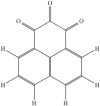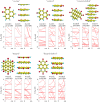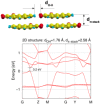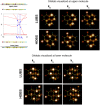Gapless edge states in (C,O,H)-built molecular system with p-stacking and hydrogen bonds
- PMID: 28852086
- PMCID: PMC5575060
- DOI: 10.1038/s41598-017-09954-z
Gapless edge states in (C,O,H)-built molecular system with p-stacking and hydrogen bonds
Abstract
The gapless edge states have been found in a 2D molecular system built with light atoms: C,O,H. This prediction is done on the basis of combined density functional theory (DFT) and tight-binding calculations. The system does not exhibit any effect of the spin-orbit coupling (SOC), neither intrinsic nor Rashba type. The band structure and the edge states are tuned with a strength of the p-stacking and O...H interactions. The elementary cell of this noncovalent structure, does not have the 3D inversion or rotational symmetry. Instead, the system transforms via a superposition of two reflections: with respect to the xz and xy mirror planes, both containing the non-periodic direction. This superposition is equivalent to the inversion in the 2D subspace, in which the system is periodic. The energy gap obtained with the DFT method is 0.11 eV, and largely opens (above 1 eV) with the GW and hybrid-DFT approaches. The bands inversion is partial, i.e. the Bloch states are mixed, with the "swapping" and "non-swapping" atomic contributions.
Conflict of interest statement
The authors declare that they have no competing interests.
Figures








Similar articles
-
Hexagonal warping effect in the Janus group-VIA binary monolayers with large Rashba spin splitting and piezoelectricity.Phys Chem Chem Phys. 2023 Apr 12;25(15):10827-10835. doi: 10.1039/d2cp05161c. Phys Chem Chem Phys. 2023. PMID: 37013675
-
Discovery of asymmetric NaXBi (X= Sn /Pb) monolayers with non-trivial topological properties.RSC Adv. 2018 Aug 6;8(49):27995-28001. doi: 10.1039/c8ra05458d. eCollection 2018 Aug 2. RSC Adv. 2018. PMID: 35542734 Free PMC article.
-
Tunable Rashba Spin Splitting in Two-Dimensional Polar Perovskites.J Phys Chem Lett. 2021 Feb 25;12(7):1932-1939. doi: 10.1021/acs.jpclett.0c03668. Epub 2021 Feb 16. J Phys Chem Lett. 2021. PMID: 33591761
-
Topologically nontrivial phase and tunable Rashba effect in half-oxidized bismuthene.Phys Chem Chem Phys. 2019 Feb 6;21(6):2899-2909. doi: 10.1039/c8cp06391e. Phys Chem Chem Phys. 2019. PMID: 30671577
-
Quantum Anomalous Hall Effect in Magnetic Doped Topological Insulators and Ferromagnetic Spin-Gapless Semiconductors-A Perspective Review.Small. 2020 Oct;16(42):e1904322. doi: 10.1002/smll.201904322. Epub 2020 Sep 11. Small. 2020. PMID: 32914584 Review.
References
Publication types
LinkOut - more resources
Full Text Sources
Other Literature Sources
Miscellaneous

